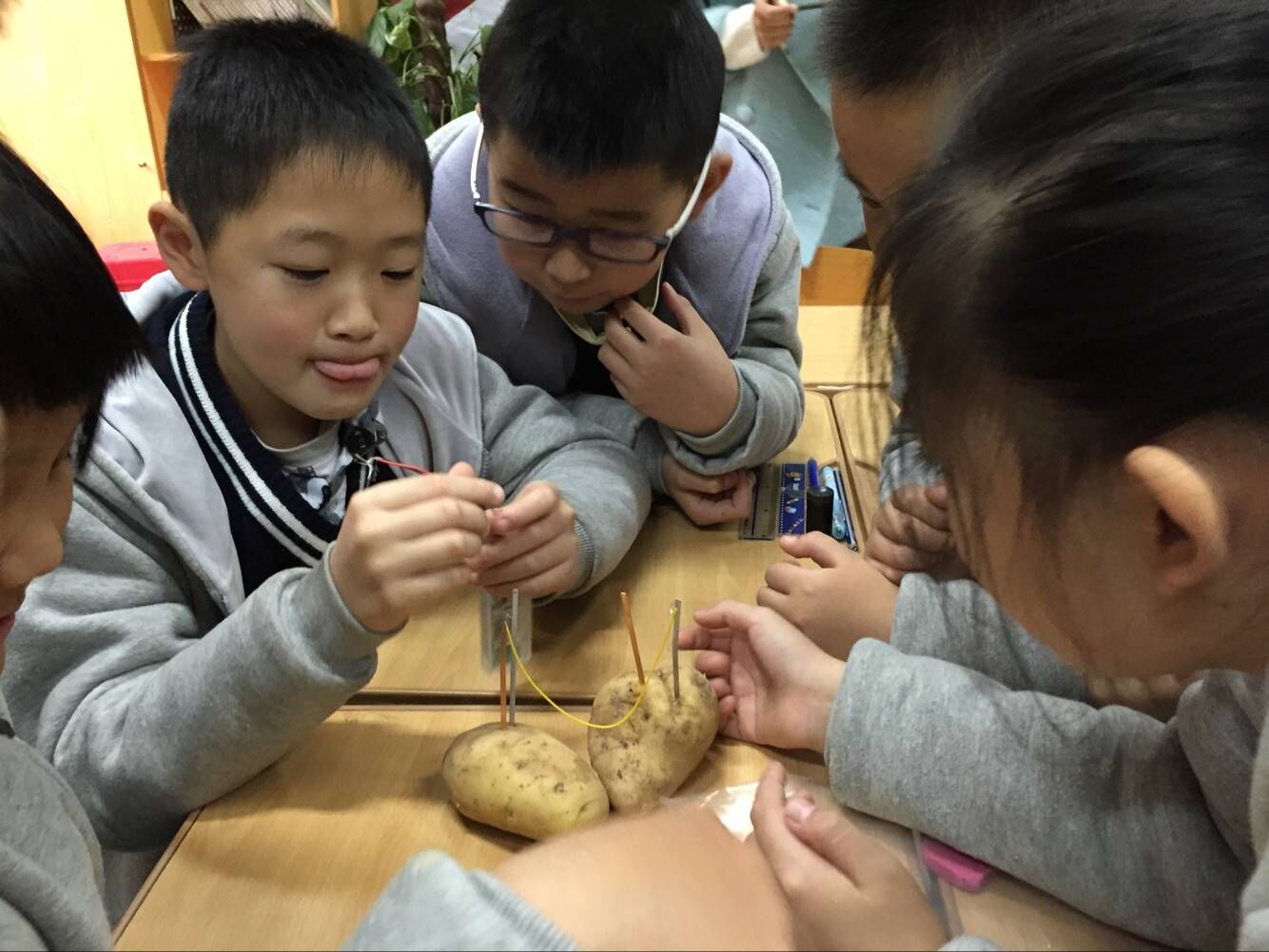不用电池,你可以制作一个时钟吗?
Making a Clock Without Batteries
Caroline
Can you imagine that you can make a clock without batteries? Yes, No batteries? If you join in teacher Tom’s class, you’ll have the chance to be a scientist as you discover how to power this digital clock using potatoes.
你可以想象制作一个没有电池的时钟吗?是的,没有电池。如果你加入Tom老师的课堂,你就会有这个当小小科学家的机会来探索如何用土豆给时钟供电。




At the beginning of the class, teacher Tom asked everyone “What is energy?” It is difficult indeed for grade three students to answer this question. But Tom taught this word by playing a game. He asked a student to come to the front and had a competition with him. They tried to push each other hard in order to win. While they were pushing each other, Tom asked the other students “Who has energy? Who has more energy?” Students got the meaning of “energy” immediately.
After that, Tom raised another question “What uses energy?” Students gave some examples,such as lights, TV and the glittering Christmas tree outside. “These things all use electricity. Can you tell me any other energy?” Tom inspired. He let students think for a while, and showed some pictures on the screen. The first one is solar energy and the second one is wind energy. In order to let student experience the wind energy, Tom even brought a hair drier to blow a girls’ hair. This kind of small-scale experiment happens frequently in Tom’s class and it not only brings happiness to students, but gives them the chance to learn by doing.
课堂一开始,Tom老师问大家“什么是能量?”对于小学生来说,这确实是一个较难回答的问题。但是Tom老师用了一个游戏来教这个单词。他请一个学生来和他比赛力量对抗,他们掌心相对,相互用力推对方。当他们玩这个游戏的时候,Tom问同学们“谁有能量?谁的能量更大?”孩子们马上便知道“energy”的意思了。然后,Tom提出了另一个问题“什么会用能量?”学生给出了很多例子,如点灯,电视和外面一闪一闪的圣诞树。“这些东西都是用电的。你能告诉其他的能量吗?”Tom启发大家。他给了学生一点时间思考,然后展示了几幅图片。第一幅图是太阳能,第二幅图是风能。为了让学生能够体验风能,Tom甚至把吹风机也带来吹一个女同学的头发。这种小范围的实验经常出现在Tom老师的课堂上。不仅给学生带来欢乐,还让他们在做中学。



The most exciting part of this class is making the potato clock. After Tom claimed that “We’re going to make our own energy”, every group got their materials for the experiment, including a digital clock with wires, some connecting wires, metal strips and two potatoes. First, students need to connect the metal strips with wires. Second, connect the black wire from the clock to the metal strips. Finally, insert the metals into the potatoes. The clock should now start to work. One group did an excellent job, for their clock started to work right after their inserted the strips into the potatoes. Tom used a very funny way to explain how it works. “The metals don’t like water. When they are in potatoes, they get angry. So the energy of angry goes into the clock.”
这堂课最令人兴奋的部分就是制作土豆时钟。当Tom宣布我们要DIY自己的能量后,每个小组拿到了他们的实验材料,包括一个数字时钟,一些导线,一些金属条和两个土豆。首先,学生需要连接金属条和导线。然后,他们要把时钟上的黑色导线和金属条连接起来。最后,将金属条插入土豆。时钟这时就应该可以开始工作了。其中一个小组非常出色,他们一插入金属条,时钟马上就开始工作了。Tom用一个非常有趣的方式来解释它的工作原理。“金属条不喜欢水。当他们在土豆里面的时候,他们非常生气。所以生气的能量就进入到了时钟里。”



If I tell you, you will forget; if I teach you, you will remember; if I involve you, you will understand. The more we involve students into our class, the more they can absorb. This is what the Maple Leaf School always pursues.
如果我告诉你,你会忘记;如果我教你,届时你记住;如果我让你参与,你就会明白。学生参与得越多,他们吸收的也就越多。这也是枫叶学校所一直追寻的。














 小学咨询群 480672539
小学咨询群 480672539